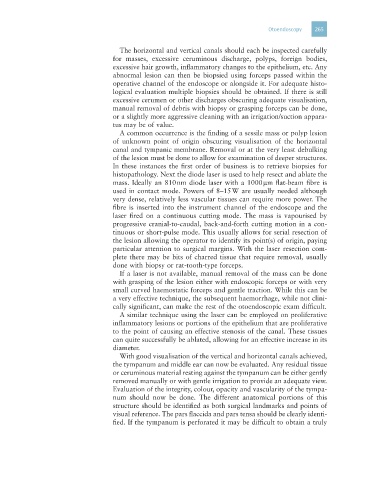Page 277 - Clinical Manual of Small Animal Endosurgery
P. 277
Otoendoscopy 265
The horizontal and vertical canals should each be inspected carefully
for masses, excessive ceruminous discharge, polyps, foreign bodies,
excessive hair growth, inflammatory changes to the epithelium, etc. Any
abnormal lesion can then be biopsied using forceps passed within the
operative channel of the endoscope or alongside it. For adequate histo-
logical evaluation multiple biopsies should be obtained. If there is still
excessive cerumen or other discharges obscuring adequate visualisation,
manual removal of debris with biopsy or grasping forceps can be done,
or a slightly more aggressive cleaning with an irrigation/suction appara-
tus may be of value.
A common occurrence is the finding of a sessile mass or polyp lesion
of unknown point of origin obscuring visualisation of the horizontal
canal and tympanic membrane. Removal or at the very least debulking
of the lesion must be done to allow for examination of deeper structures.
In these instances the first order of business is to retrieve biopsies for
histopathology. Next the diode laser is used to help resect and ablate the
mass. Ideally an 810 nm diode laser with a 1000 µm flat-beam fibre is
used in contact mode. Powers of 8–15 W are usually needed although
very dense, relatively less vascular tissues can require more power. The
fibre is inserted into the instrument channel of the endoscope and the
laser fired on a continuous cutting mode. The mass is vapourised by
progressive cranial-to-caudal, back-and-forth cutting motion in a con-
tinuous or short-pulse mode. This usually allows for serial resection of
the lesion allowing the operator to identify its point(s) of origin, paying
particular attention to surgical margins. With the laser resection com-
plete there may be bits of charred tissue that require removal, usually
done with biopsy or rat-tooth-type forceps.
If a laser is not available, manual removal of the mass can be done
with grasping of the lesion either with endoscopic forceps or with very
small curved haemostatic forceps and gentle traction. While this can be
a very effective technique, the subsequent haemorrhage, while not clini-
cally significant, can make the rest of the otoendoscopic exam difficult.
A similar technique using the laser can be employed on proliferative
inflammatory lesions or portions of the epithelium that are proliferative
to the point of causing an effective stenosis of the canal. These tissues
can quite successfully be ablated, allowing for an effective increase in its
diameter.
With good visualisation of the vertical and horizontal canals achieved,
the tympanum and middle ear can now be evaluated. Any residual tissue
or ceruminous material resting against the tympanum can be either gently
removed manually or with gentle irrigation to provide an adequate view.
Evaluation of the integrity, colour, opacity and vascularity of the tympa-
num should now be done. The different anatomical portions of this
structure should be identified as both surgical landmarks and points of
visual reference. The pars flaccida and pars tensa should be clearly identi-
fied. If the tympanum is perforated it may be difficult to obtain a truly

